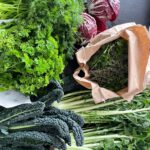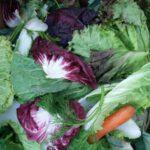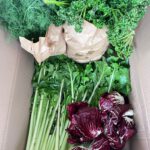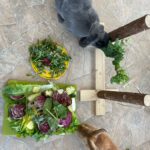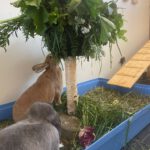There are various methods or „types“ for feeding rabbits. We would like to introduce them here.
Contents
Ad libitum feeding
Feeding rabbits with a wide variety of natural foods in abundance is the most natural feeding method and, therefore, especially healthy.
Meaning of the term
Ad libitum (abbreviated as ad lib.) means „at one’s pleasure“ or „as desired.“In relation to rabbit nutrition, it means that rabbits have access to a diverse, species-appropriate selection of food around the clock, allowing them to freely choose according to their physical needs (as desired).


The individual foods can be offered in separate bowls. Hay should never be missing! Hay is not visible in this picture.
These three pillars are essential for ad libitum feeding:
- A variety of foods is available around the clock, ensuring they never run out.
- Emphasis is placed on diversity and variety.
- Foods are selected to be natural and suited to a rabbit’s dietary needs.
True free selection only occurs when rabbits have constant access to a wide range of vegetables, herbs, grasses, branches, leaves, and wild plants. Selection is key to vitality, as rabbits eat in line with their physical needs only when they can make their own choices.
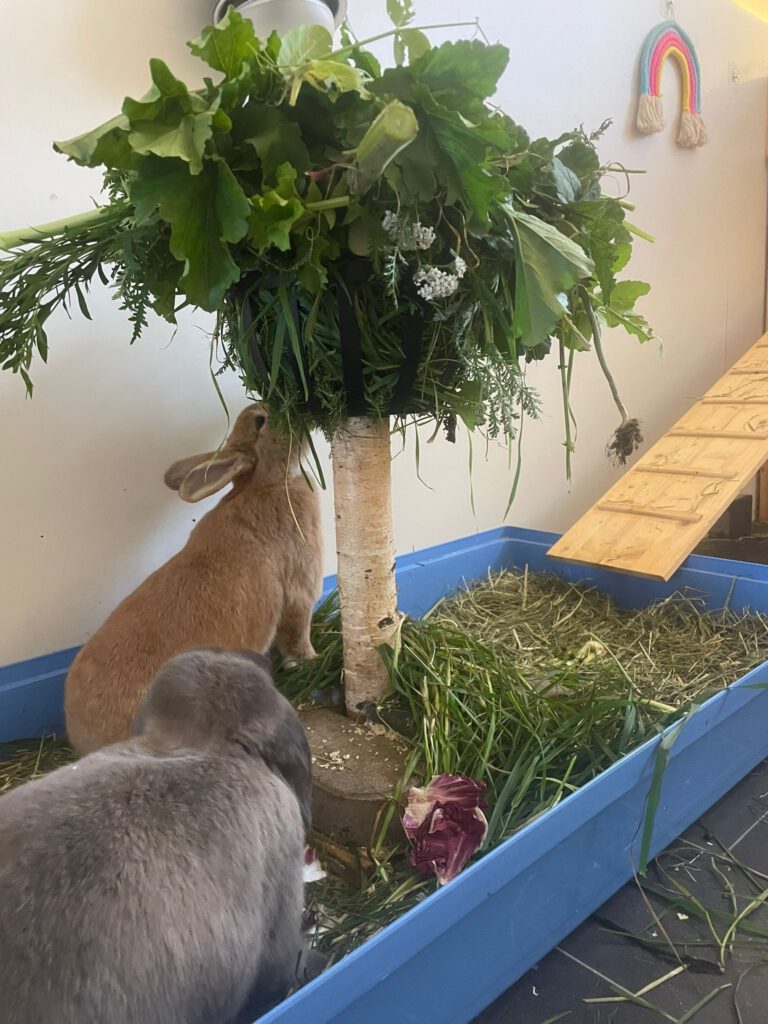
The Advantage Over Other Feeding Methods
With rationed feeding, a rabbit will quickly consume its portion, regardless of whether the food mix is ideal. This requires the owner to carefully determine the best combination of foods. But is there truly a „perfect“ mix? Doesn’t each rabbit have individual needs, influenced by its unique physiology and circumstances?
This is the key advantage of ad libitum feeding: the rabbit eats precisely according to its needs, ensuring optimal nutrition and well-being.
Requirements for This Feeding Method
The essential pillars of ad libitum feeding are crucial for its success. Here is a detailed explanation:
Constant Availability
A wide variety of foods should always be available and should never „run out.“ This requires close monitoring to estimate quantities accurately and regular checks (ideally twice daily). On average, rabbits consume about 200g of fresh food per kilogram of body weight each day.
Variety
A range of food groups should always be represented: meadow plants (such as grass and herbs), vegetables, branches, culinary herbs, and more (see the full list of recommended foods).
R
Proper Selection
The most important food group is meadow plants, as they closely mimic a rabbit’s natural diet and form the main component of wild rabbit nutrition. Meadow grasses and herbs should be available around the clock, just as they are in nature. Since they are the most crucial part of the diet, they must never run out. However, nature also provides other essential foods, such as branches with bark and leaves, foliage, vines, flowers, and many other edible plants. These should also be offered consistently. In addition, all other recommended food groups should be provided as supplementary options.
For owners who cannot access the plant diversity found in nature (for example, during winter or in urban areas), it is still important to offer as much natural food as possible. Even in winter, branches and ground plants can be collected. Additionally, offer leafy vegetables, high-quality hay, branches, and, in small amounts, dried herbs. When offering these substitute foods, it is crucial to maintain variety. Alongside as many natural ingredients as possible, there should always be a diverse plate of fresh food, with a focus on leafy greens (at least 80%, preferably more), and a large bowl with a wide selection of herbs.
It is recommended to strictly ration seeds, as rabbits tend to select energy-dense foods, but do not require such high-energy nutrition in these feeding systems, which can lead to obesity.
Experiences: Transitioning
When switching to ad libitum feeding from other feeding methods, a gradual transition is necessary to allow the digestive system to adjust to the new foods and quantities. Therefore, the variety and amount of food should be slowly increased until a large variety and sufficient quantity are offered.
For those who prefer to be cautious, it’s best to start by offering leafy vegetables, meadow plants, and fresh/dried herbs ad libitum, and only then introduce the other foods.
During the transition, it is recommended to feed many small portions throughout the day, gradually increasing the amount until some food is left over by the next feeding. Once this occurs, you can begin feeding the amount needed for the day in two portions, ensuring that there is still a small amount of each food left by the time of the next check.
Rationed Feeding
The most widely known feeding method is rationed feeding. In this approach, the rabbit is fed in set portions, receiving a limited selection of food that the owner prepares.
Wild rabbits, however, have access to a wide variety of foods around the clock, making rationed feeding somewhat unnatural.
With this method, the rabbit consumes larger amounts of food at specific feeding times, rather than eating gradually throughout the day at its own pace. Many rabbits also tend to gobble their food when it’s rationed, which can lead to digestive problems such as stomach overload or bloating.
Additionally, rationed feeding prevents the rabbit from selecting its food according to its preferences. For this reason, some experts, such as Hörnicke, advise against this feeding method.
„They are unable, as they would in nature or with a varied fresh food diet, to adjust their nutrient intake qualitatively according to their metabolic state by selectively choosing certain food components.“
Hörnicke, H. (1978): Futteraufnahme beim Kaninchen – Ablauf und Regulation. Übersetzung Tierernährung 6, 91-148.
Furthermore, it should be noted that with rationed feeding, the focus is often on hay, which, when it makes up the majority of the diet, can lead to problems.
The main diet
A completely rationed diet is not suitable for rabbits, as it would severely disrupt their digestion. Therefore, one or more foods are typically offered ad libitum, while the remaining foods are rationed. Common staple foods include hay, branches, and water.
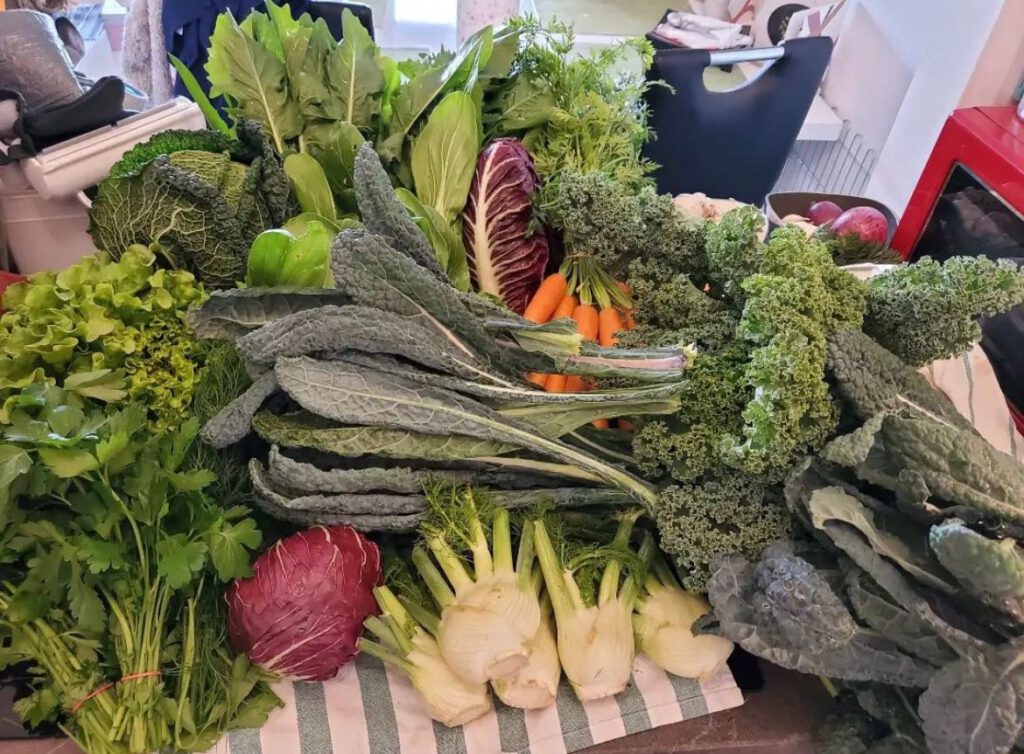
To minimize the problems associated with a hay-based diet, it is recommended to offer additional components ad libitum. At least one fresh food (such as vegetables or forage plants) and other roughage sources should also be provided.

The Portions
Portions should be given multiple times a day. Feeding only once a day is not recommended with rationed feeding, as it can increase the risk of digestive issues. The composition of the portions is very important to prevent nutritional deficiencies!
A portion typically includes:
- Fresh meadow forage (if available)
- Culinary herbs
- A variety of mixed vegetables (with a focus on leafy greens)
The portions should be large, varied, and diverse, with an emphasis on meadow greens, herbs, and leafy vegetables.
A certain amount of fresh food is vital for a rabbit’s health, as insufficient fresh food can lead to nutrient deficiencies. Additionally, a lack of it can increase the risk of bladder and kidney problems. You can judge the amount by observing your rabbits: if they finish all the food quickly without leaving any, the portion size is likely too small. Rabbits should be able to „fill up“ and appear content. If they are constantly begging for food, it could be a sign they are not receiving enough fresh food. As a guideline for beginners, the minimum amount is around 200 to 500g per day per rabbit (depending on size and living conditions). Ideally, the goal should be to get as close as possible to an ad libitum feeding approach, offering as much fresh food as possible.
Important! If you choose to feed your rabbits with rationed portions, it’s crucial to have a solid understanding of their natural nutritional needs, anatomical features, and the nutrient content of various foods to ensure they are properly fed. Ad libitum feeding is much safer. However, a carefully planned and varied rationed diet can also be an effective feeding method.





